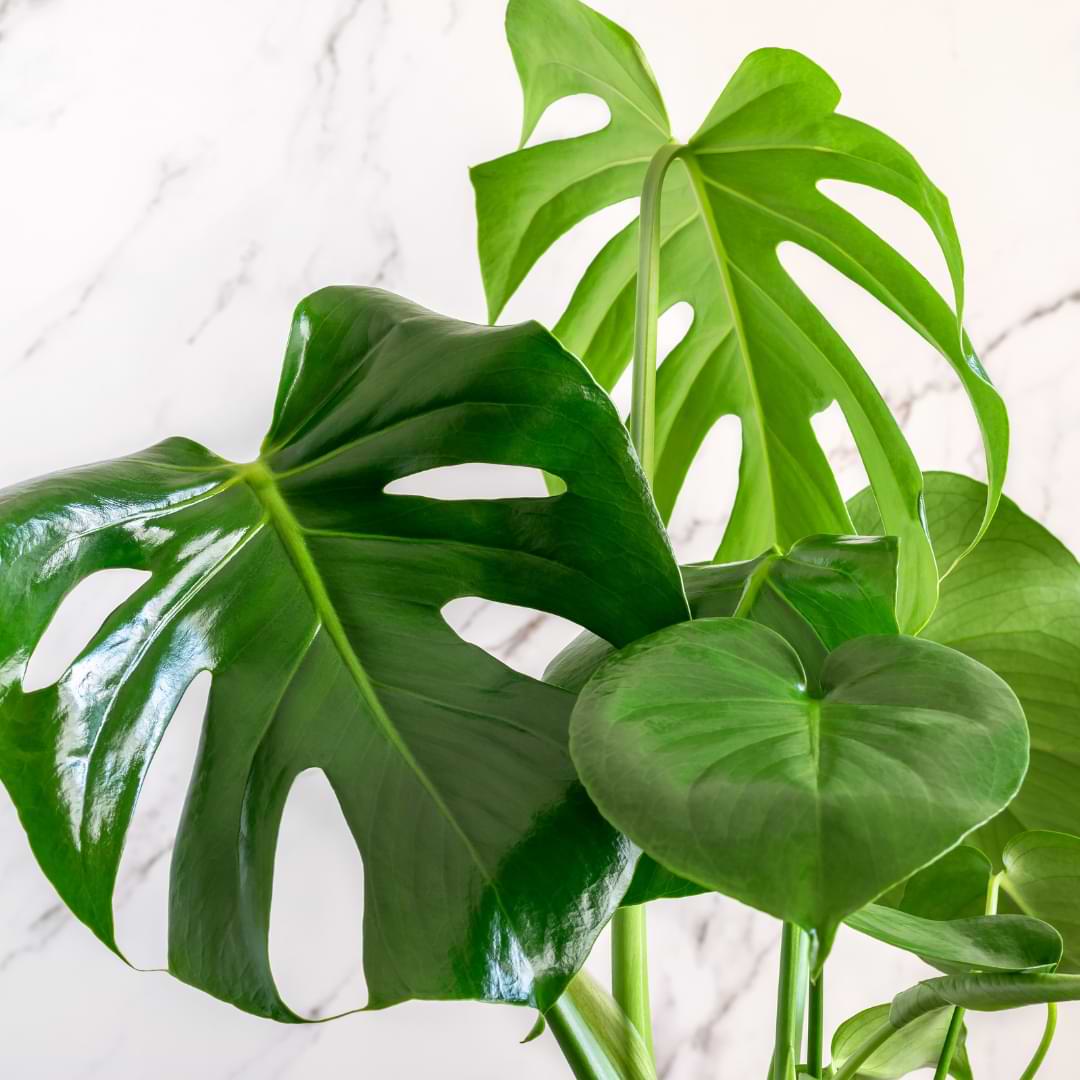Monstera plants are typically quite hardy, but every once in a while, you may find yourself dealing with a droopy monstera. The trouble with droopiness is that it can have many different causes. Some of these causes may require your attention and some won’t.
It’s important to understand how to read other signs your monstera may be exhibiting and use the process of elimination to determine the cause of your plant’s droopiness so you can take action to fix it (or leave it alone, if that’s what your plant needs!).
In this article, we’ll walk you through the various potential causes of droopiness in monsteras and how to fix (and prevent) them.
Table of Contents
Droopy Monstera Leaves & How to Fix
If your monstera’s got a case of the droops, it can help to check some other factors, such as soil moisture level, and to consider your monstera’s current care routine and what may be causing the issue.
If you notice that your monstera isn’t its usual perky self, consider the following potential causes.
Underwatering or Overwatering
Both overwatering and underwatering can cause your monstera to droop (frustrating, we know), and both of these are quite common causes. To determine whether one of these might be the problem, check the moisture level of the soil and take a good, hard look at your watering routine.
If the soil still feels wet (or if a moisture meter reads wet) a week or more after you last watered, your plant may be overwatered.
Underwatering can also cause droopiness. Luckily, this is easier to diagnose and fix than overwatering.
How to Fix
If you determine that your monstera is overwatered, this might not mean that you’re watering too much or incorrectly. (Though if you’re watering more than once a week, you’re probably watering too much.) The more likely issue is that the pot and soil aren’t draining well enough. For starters, make sure your pot has drainage holes. If it doesn’t, repot your monstera into a pot that does—pronto. It won’t last long in a pot with no drainage!
If the pot has holes but the soil still isn’t draining, it’s possible that the potting mix is too dense and holds on to water for too long, or that it’s become hard and compacted, which may cause it to have trouble absorbing water readily, and then draining once it does absorb that water. It’s also possible that your monstera’s roots might be getting crowded and blocking the drainage holes. You might see roots popping out of the bottom of the pot or growing in a circle around the inside of the pot. These are both signs that your monstera is ready to go up a pot size!
If your soil isn’t draining for whatever reason, you’ll want to repot your plant into a pot with drainage and a light, chunky potting mix that drains well but holds a little moisture. Our Premium Monstera Potting Mix is the perfect choice for monstera species and other aroids.
We also love this DIY recipe from Kaylee Ellen on YouTube:
- 5 parts orchid bark
- 4 parts coir
- 5 parts perlite
- 2 parts activated charcoal
- 2 parts worm castings
If your monstera is underwatered, the solution is easy: give it a drink! If the soil feels dry a few inches down or if a moisture meter reads dry, give the soil a good soaking and let it drain. Going forward, make sure to water when the top few inches of soil feel dry or when your moisture meter reads 3-4.
Incorrect Lighting
Monsteras need plenty of bright, indirect sunlight to thrive, and they may start to droop if they don’t get enough.
Too much direct light may also cause droopiness in some cases, but this is much less common. If your monstera is getting too much light, you’ll probably notice scorched leaves before anything else.
If your monstera isn’t getting at least 8 hours of bright light every day and if it isn’t near a bright window, this might be the problem. You might notice this issue when the seasons change and the sun’s position in the sky changes, which could alter your monstera’s lighting conditions.
How to Fix
If your monstera needs more light, give it more light!
An east-facing window is the best spot for monstera plants, and a south- or west-facing window can also be a good choice as long as the sun’s rays don’t shine directly on the leaves. (If they do, try filtering the light with a sheer curtain or just scooting the plant back far enough that it’s not right in the sun’s path.)
If you aren’t able to provide enough natural light, monsteras respond well to full-spectrum grow lights. We love these bulbs that you can simply screw into your regular light fixtures!
Temperature Shock
If your monstera experiences an abrupt temperature change—usually going from warm to cold temperatures very quickly—you’ll probably notice some drooping.
How to Fix
If the temperatures in the monstera’s living space stay between 85 and 65 degrees Fahrenheit, you may just need to give your plant some time to adjust.
But if your plant is near a drafty window, door, or a vent that blasts the plant with cold air, make sure to move your monstera or cover the source of cold air immediately.
Dry, hot air may also cause droopiness, though this is less common. You’ll probably run into problems with dry leaves before droopiness become a major issue.
Fertilizer Problems
Overfertilization can cause a monstera plant to droop. If you’re fertilizing in the fall or winter when the plant is most likely dormant, if you started using a new fertilizer or if you’re combining slow-release and liquid fertilizers, those minerals might be building up in the soil and harming your plant.
How to Fix
To remove excess nutrients from the soil, start by scooping white crust off the surface of the potting mix.
Then put your plant in the tub or sink and slowly pour water over the soil, letting it drain out the bottom. Repeating this process, called leaching, once or twice should help flush the mineral buildup out of the potting mix.
If the problem persists, you may need to repot into fresh soil.
Pests
Insects like spider mites, mealybugs, thrips, etc., can suck the juices out of your monstera’s leaves and stems, causing it to droop from lack of turgor pressure.
If you notice droopiness along with small red or brown dots, cottony webbing, sticky residue, or actual insects, you’ll need to act fast to save your plant.
How to Fix
In general, the best way to deal with insects is to manually remove as many as you can and then treat the plant with an insecticide.
Rinse the plant with a kitchen sprayer or hose to wash as many of the insects off as possible. Be sure to tip the pot to avoid washing them right into the soil. Using a lint roller on the leaves can also be effective.
Then spray your plant with diluted neem oil, Leaf Armor, or insecticidal soap. You may need to do this a few times over several weeks to kill off new generations of pests as they hatch.
Stress After Repotting
If you’ve recently repotted or moved your monstera, your plant is probably experiencing shock. Plants don’t typically move around in nature, so being moved or repotted is a big deal!
How to Fix
If you’ve repotted or moved the plant in the past week or two, leave your plant alone and give it a chance to adjust. The last thing you want to do right now is give it more change to deal with! It should perk back up on its own in a week or so.
Droopy Monstera Cutting After Propagation
Pruning or taking a cutting from your plant can also cause shock. If you recently pruned or propped, this is the likely cause of your drooping.
How to Fix
Again, your plant needs time to adjust to change, so the best course of action here is to do nothing. Make sure your monstera gets plenty of light and consistent care, and it should be back to its old self in a week or two.
Drooping Stems From Lack of Support
If you haven’t made any recent changes and your plant appears to be in great health—and even growing—it might be time to introduce a support so your monstera has something to climb!
In their natural habitat, monstera plants climb trees and other surfaces, so it’s important to give them something to climb so they don’t fall over or try to climb up your walls and furniture.
How to Fix
You have a few options here. Some monstera owners like moss poles (here’s how to make one of your own) while others prefer trellises. Either one can work!
Droopy Monstera Causes FAQ
FAQ: Should I remove drooping leaves?
Unless the leaves are actually damaged (as in ravaged by insects or covered in spots that won’t heal), you shouldn’t remove them. As long as the leaves aren’t discolored, they should perk back up.
FAQ: How long will it take my monstera to recover?
It depends on the cause of the droopiness. If your monstera just needed water, it should perk back up after a few hours. When root shock is the problem, it can take about a week. An overwatered or overfertilized plant will need repotting, your monstera will also have to recover from THAT, which means it can be a few weeks before your plant looks happy again. Hang in there, though!
Don’t Give Up on Your Droopy Monstera!
In most cases, it’s quite easy to revive a droopy monstera. Droopiness is usually an early warning sign of problems, and it doesn’t damage those leaves, so your plant will almost always be able to make a full recovery!
Looking for more help with your monstera? Be sure to join and post inside our helpful community on Facebook!





